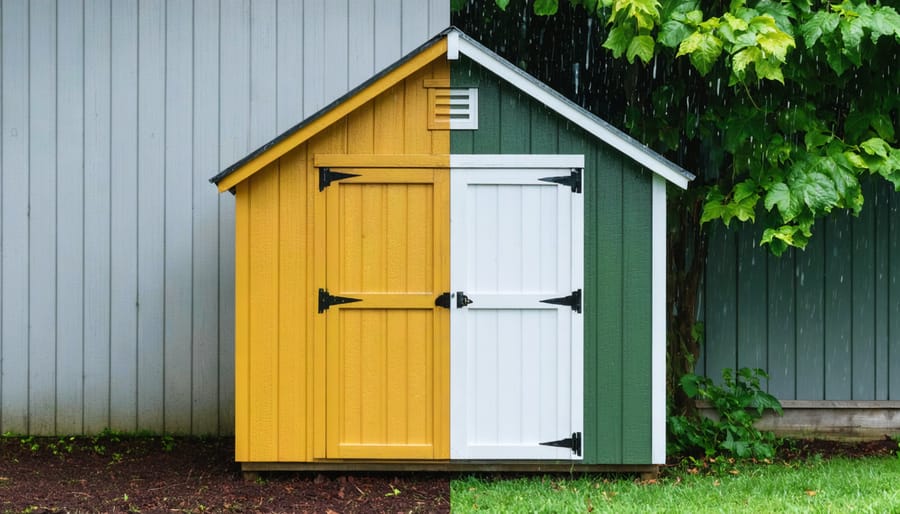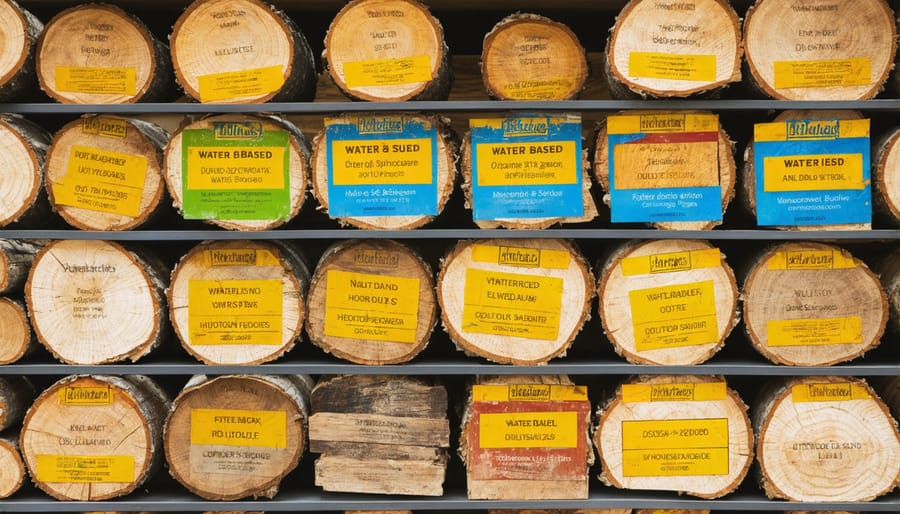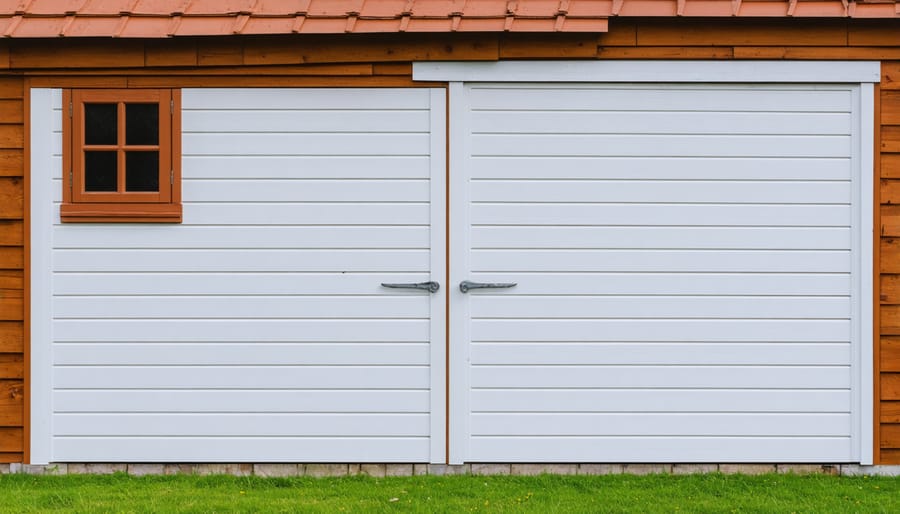Keep Your Garden Shed Standing Strong: Essential Wood Preservative Tips

Protect your garden shed from rot, decay, and weather damage with the right wood preservative – a critical investment that extends your structure’s life by decades. Modern preservatives offer more than just protection; they enhance the wood’s natural beauty while creating a robust barrier against moisture, UV rays, and destructive fungi. Whether you’re treating a new shed or maintaining an existing one, choosing the proper preservative and application method determines how well your outdoor storage space withstands the elements. From water-based solutions that dry quickly to deep-penetrating oil-based treatments that offer maximum protection, today’s preservatives combine advanced technology with environmental responsibility to keep your garden shed sturdy and attractive for years to come.
This introduction balances technical authority with practical guidance, using clear language while maintaining an engaging tone. It addresses the primary concerns of homeowners (protection, longevity, aesthetics) while setting up the article to delve into specific product recommendations and application methods.
Why Garden Sheds Need Wood Preservative
Common Threats to Wooden Sheds
Garden sheds face several environmental challenges that can compromise their structural integrity and appearance. Moisture is perhaps the most persistent threat, leading to wood rot, warping, and deterioration. Rain, ground moisture, and humidity can all contribute to this problem, making proper waterproofing wooden surfaces essential for long-term protection.
UV rays from sunlight pose another significant challenge, causing wood to fade, crack, and become brittle over time. This sun damage not only affects the shed’s appearance but can also weaken its structural components.
Insects, particularly termites and woodworms, can quietly destroy wooden structures from the inside out. These unwanted visitors can cause extensive damage before their presence is even noticed. Additionally, fungal growth, including various types of mold and mildew, thrives in damp conditions and can spread rapidly across untreated wood, leading to both aesthetic issues and potential health concerns for shed users.

Long-term Benefits of Preservation
Investing in quality wood preservative for your garden shed pays dividends in the long run. By protecting your shed from the start, you can easily double or triple its lifespan, potentially saving thousands in replacement costs. A well-preserved shed can last 20-30 years, compared to just 7-10 years for an untreated structure.
Beyond the obvious financial benefits, regular preservation maintains your shed’s appearance and structural integrity. This means fewer repairs, no warped boards, and minimal maintenance costs over time. You’ll also avoid common issues like rot, fungal growth, and insect infestations that typically plague untreated sheds.
Think of wood preservative as an insurance policy for your outdoor storage investment. The small upfront cost and occasional reapplication every few years is minimal compared to the expense and hassle of replacing an entire shed. Plus, a well-maintained shed adds value to your property and keeps your stored items safe and dry year after year.
Choosing the Right Wood Preservative

Water-Based vs. Oil-Based Preservatives
When it comes to protecting your garden shed, you’ll typically choose between water-based and oil-based preservatives, each offering distinct advantages. Water-based preservatives are increasingly popular among homeowners, thanks to their eco-friendly nature and easy cleanup with soap and water. They dry quickly, usually within 1-2 hours, and provide excellent protection against rot and fungal growth. Plus, they won’t leave your shed with that strong chemical smell that some people find off-putting.
Oil-based preservatives, on the other hand, offer superior wood penetration and typically last longer between applications. They create a water-resistant barrier that’s particularly effective in harsh weather conditions. While they take longer to dry (usually 24-48 hours) and require mineral spirits for cleanup, many users prefer them for their durability and deep, rich finish that enhances the wood’s natural beauty.
For best results with water-based preservatives, apply them during dry weather when temperatures are between 50-85°F. They’re ideal for sheds that need frequent color updates, as you can easily apply new coats over time. Oil-based options work well in most weather conditions and are perfect for sheds in particularly wet or humid climates, though you’ll want to ensure good ventilation during application.
Choose water-based if you prioritize easy application and environmental friendliness, or go with oil-based if maximum durability and weather resistance are your top concerns.
Environmental Considerations
When it comes to protecting your garden shed, choosing eco-friendly wood preservatives isn’t just good for the environment – it’s also safer for your family and pets. Many modern wooden shed maintenance solutions now offer environmentally conscious options that work just as effectively as traditional treatments.
Water-based preservatives are leading the way in eco-friendly protection. These products typically contain natural oils like linseed or tung oil, combined with mineral-based preservatives that pose minimal environmental risk. They’re particularly effective for above-ground applications and don’t release harmful vapors during or after application.
Plant-based preservatives are gaining popularity too. Cedar oil, for instance, naturally repels insects and prevents rot while being completely biodegradable. Similarly, borate-based treatments offer excellent protection against fungi and insects while having low toxicity levels for humans and pets.
When applying any preservative, consider these eco-friendly practices:
– Choose a calm day to prevent overspray
– Use drop cloths to protect surrounding soil and plants
– Dispose of excess product at appropriate facilities
– Store preservatives in sealed containers away from water sources
Remember that while natural preservatives might need more frequent reapplication, this trade-off is worth considering for the environmental benefits. Many homeowners find that these greener alternatives actually enhance the wood’s natural beauty while providing reliable protection.
Application Process
Preparation Steps
Before applying any wood preservative, proper surface preparation is essential for the best results. Start by thoroughly cleaning the shed’s exterior with a stiff brush to remove dirt, debris, and loose paint. If you notice any green or black patches, these are likely mold or algae and should be treated with a fungicidal wash.
Check for any damaged or rotting wood and replace these sections before proceeding. Sand down rough areas and remove any loose splinters to create a smooth surface. Pay special attention to corners and joints where moisture tends to accumulate.
If your shed has old preservative or paint, you’ll need to strip this off using a chemical stripper or sand it down. Once stripped, wipe the surface with white spirit to remove any residual dust or cleaning products. Allow the wood to dry completely – typically 24-48 hours in good weather.
For new sheds, simply ensure the wood is clean and dry before application. Remember to check the weather forecast; you’ll want at least 24 hours of dry conditions after applying the preservative.
Application Techniques
Before applying wood preservative, gather your essential tools: a brush or roller, protective gloves, goggles, and a dust mask. Clean the shed’s surface thoroughly with a stiff brush to remove dirt, cobwebs, and loose wood fibers. For best results, choose a dry day with moderate temperature, ideally between 50-85°F.
Start by stirring the preservative thoroughly – don’t shake it, as this can create bubbles. Apply the first coat using long, even strokes, working in the direction of the wood grain. Pay special attention to end grains, joints, and areas prone to water collection, as these are most vulnerable to rot.
Allow the first coat to dry completely according to the product instructions, typically 24-48 hours. Apply a second coat for maximum protection, especially on newer wood or previously untreated surfaces. Don’t forget to treat both interior and exterior surfaces, including door frames and window sills.
For extra protection in high-moisture areas, consider applying a third coat to the shed’s base and any ground-contact points. Always work in a well-ventilated area and ensure proper coverage for lasting results.

Maintenance Schedule
To maintain your shed’s protection, plan on reapplying wood preservative every 2-3 years, or sooner if you notice signs of wear. In areas with harsh weather, annual treatment may be necessary. Look for early warning signs like water beading failure, wood discoloration, or a chalky surface texture. When climate-proofing your shed, pay special attention to south-facing walls and areas near the ground, as these typically experience more weathering. Before reapplication, clean the surface thoroughly and allow it to dry completely. Keep a calendar reminder for regular inspections, especially after severe weather events. A well-maintained protective coating will significantly extend your shed’s lifespan and keep it looking great for years to come.
Expert Tips and Common Mistakes
Here’s what the pros want you to know: always test your preservative on a small, hidden area first to ensure it doesn’t discolor your shed unexpectedly. Apply preservative when the weather forecast shows at least 48 hours of dry conditions, and the temperature is between 10-25°C (50-77°F) for optimal absorption.
A common mistake is rushing the preparation phase. Never skip sanding and cleaning the wood surface – this can lead to patchy absorption and reduced effectiveness. Similarly, don’t apply preservative to damp wood, as this prevents proper penetration and can trap moisture inside.
Make sure to treat the entire shed, including hard-to-reach areas and especially the base where moisture tends to accumulate. Many DIYers forget to treat the underside of floor joists, which often leads to premature rotting.
When applying, work in the direction of the wood grain and don’t forget to treat cut ends and joints thoroughly – these are particularly vulnerable to water damage. Avoid over-application; multiple thin coats are better than one thick coat that can create a film and trap moisture.
Remember to maintain adequate ventilation during and after application. Many homeowners make the mistake of closing up their shed immediately after treatment, which can slow drying and create harmful fume build-up.
Protecting your garden shed with the right wood preservative is essential for ensuring its longevity and maintaining its appearance. By following proper preservation techniques and choosing quality products, you can extend your shed’s life by many years while keeping it looking great. Remember to assess your shed’s condition annually, reapply preservatives as needed, and address any issues promptly. Whether you’ve chosen a water-based or oil-based preservative, consistent maintenance is key. With the right approach to wood preservation, your garden shed will continue to provide reliable storage and enhance your outdoor space for years to come. Make the investment in proper preservation today, and enjoy the peace of mind that comes with a well-protected garden shed.

